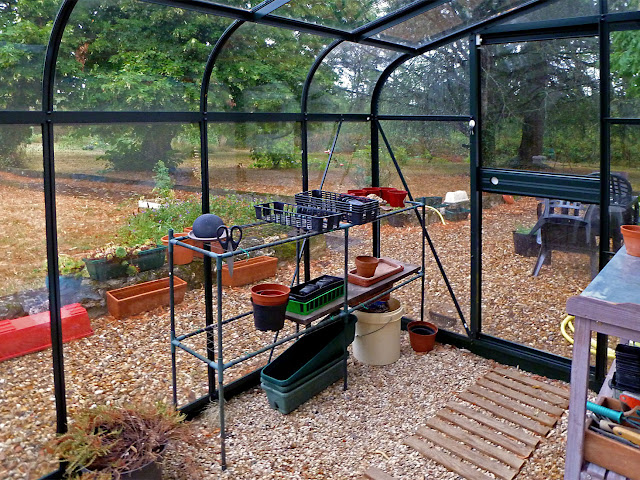Here's a photo I took yesterday as the rain ended. I was looking out the kitchen window, above the front gate, looking over toward the neighbors' yard. I had just come back from the supermarket, and I had gotten pretty wet as I loaded my groceries into the car during a heavy shower. By the time I got home, 10 minutes later, the rain had ended. I just checked the rain gauge and I see we had about 23 millimeters of rainfall in 12 hours' time. That's just short of an inch of rain.
Here's evidence of some of the "damage" we've suffered during this summer's "heat storms." Usually, the laurel hedge around our property stays a bright, deep green color all summer. It has deep roots, and it has survived the drought. But as you can see, the top leaves have been scorched by the heat and intense sun. I don't remember this happening before — not even in 2003, the summer of the great heat wave. That summer, we had high temperatures but also more frequent rains in the form of thunderstorms.
This is the little glassed-in room I call the sunporch. This space was open to the elements when we came here in 2003, and in autumn and winter it was always full of dead leaves that the wind blew in. So in 2004, we had sliding glass doors installed to close it in. We ended up putting these wooden shelving units in and bolting them to the walls. Now the space is full of potted plants — as well as decorative rocks I pick up when I go out for walks in the vineyard.
The suporch is the main entrance to the house. It looks good this summer, compared to other years, because we have had so much sunny weather. Some years, when the weather is cloudier, it's almost too dark in here for plants to be able to thrive. Not this year! The sunporch faces east so is protected from afternoon sun and heat. Once a year, at least, I empty it all out, clean the porch and shelves thoroughly, and re-pot the plants as needed before I put them back in.
A couple of years ago, after realizing how well the glass doors in the sunporch insulated the downstairs entryway from wintertime drafts, we decided to give the back door of the house the same treatment. We bought a lean-to greenhouse as a kit and we got two competent guys to install it for us. It didn't cost much more than we would have paid to simply have a new, airtight back door put in. This summer, we've realized that we'll need to take all the plants out of this west-facing greenhouse every spring, before the hot summer sun burns them up.






The Dipladenia in the planter on the kitchen's window sill looks great. Didn't seem to have suffured from the heat!
ReplyDeleteCorrected my metric system error re: rainfall. Thanks. The metric system will never be second nature to me because I didn't grow up with it. You probably have the same problem with feet and inches, pounds and ounces, etc.
DeleteIt obviously loved the heat. It is a tropical plant after all. And it's in boxes under an east-facing window, so it doesn't get the intensely hot afternoon sun.
ReplyDeleteSo glad you got some rain finally. Your indoor plants are beautiful. I'm getting a little collection of plants that I will need to bring inside in October. I wish I had a little green house like yours.
ReplyDeleteOne of our problems with keeping house plants is that we can't put them in front of or under windows because all the all the windows have radiators in under them. The heat from the radiators dries the plants out and they suffer. So having the greenhouse is really practical. If it gets really cold outside we have an electric radiator we can put in the green house (not too close to the plants) to keep them from suffering frost damage.
DeleteWow, burned leaves on the laurel hedge-- that really is extreme. Glad you finally got some rain.
ReplyDeleteWell, it's not exteme or costly damage, but it is a sign of how hot and dry it has been. It's hot again today and, unfortunately, because the ground is wet now the relative humidity is really high. You can't win, can you?
DeleteWow your clematis in the first picture is just beautiful! Hopefully the rain will help the plants.
ReplyDeleteIt's not clematis but Dipladenia aka Mandevilla sanderi I think.
Delete